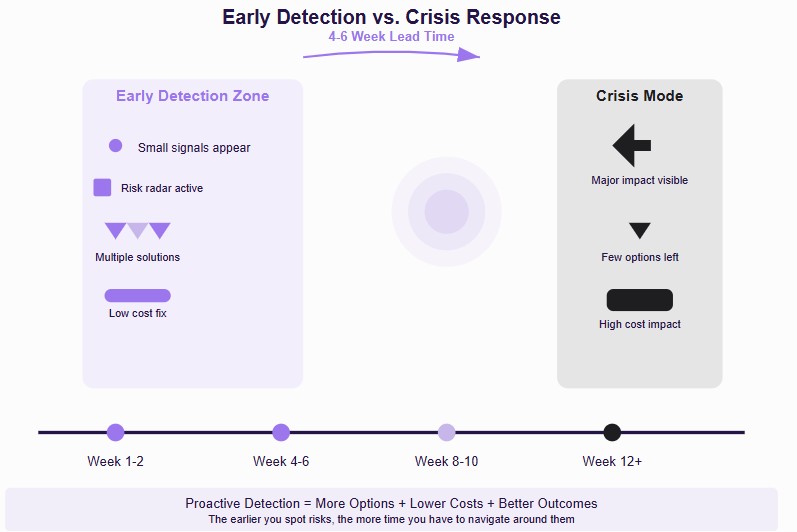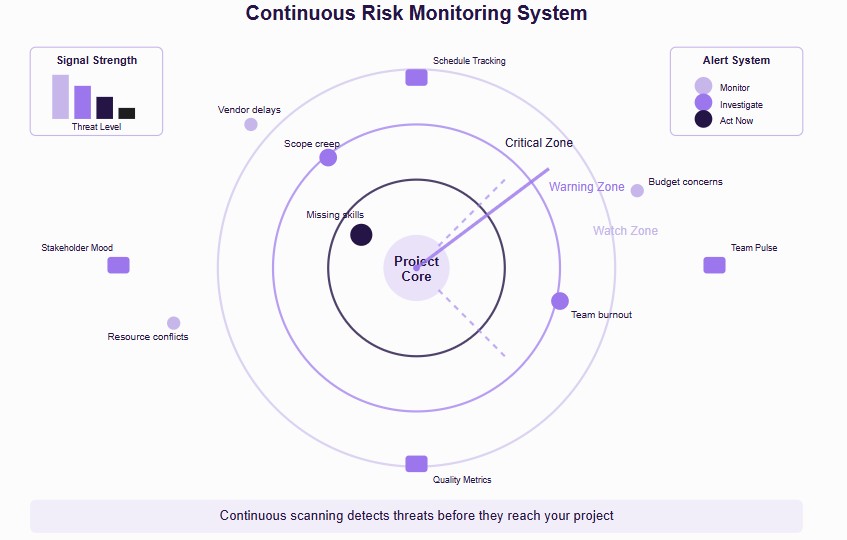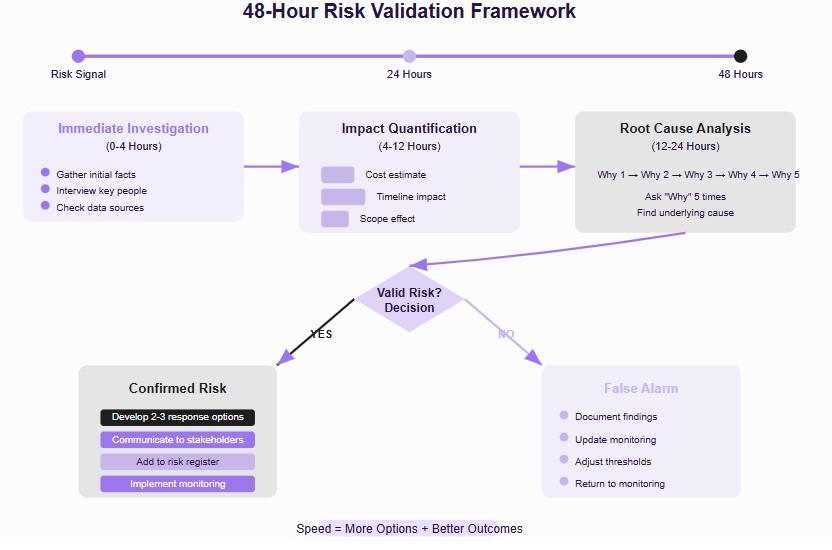Most project risks don’t crash the door; they slip in quietly. A teammate stops responding on time. A deadline is “just a bit off.” Small signs snowball fast. Mastering how project managers can spot the risks early is what separates confident leadership from constant firefighting.
The earlier you detect the drift, the easier it is to steer the project back on course - before the damage becomes visible.
In this article, we will explore:
- Get 4-6 weeks ahead by using this 6-step risk spotting system
- Pick the right tool to catch project risks before they escalate
The 6-step risk detection framework that gives project managers 4-6 weeks lead time on threats
Most project failures aren't caused by sudden disasters; they're the result of early warning signs that went unnoticed. Smart project managers don't wait for problems to surface; they hunt for risks before they become issues.
This proven framework transforms you from a reactive firefighter into a proactive risk detector, giving you 4-6 weeks of lead time on most project threats.
Step 1: Establish risk detection windows (week 1)
The foundation of early risk detection starts before your project officially begins. This pre-emptive approach allows you to identify potential landmines while you still have maximum flexibility to navigate around them.
Before project kickoff:
- Conduct a comprehensive SWOT analysis to map internal weaknesses and external threats
- Review 3-5 similar past projects for recurring failure patterns and lessons learned
- Interview key stakeholders individually to uncover concerns they won't voice in group settings
- Create an initial risk register with 15-20 potential risks before detailed planning begins
During project charter development::
- Question every assumption in the business case by asking, "What if this assumption is wrong?"
- Identify all critical dependencies and single points of failure in your project ecosystem
- Map stakeholder influence and resistance levels to spot political risks early

Pro Tip: The best time to find risks is when stakeholders are still optimistic and willing to share concerns openly. Once the project starts, people become more guarded about admitting potential problems.
Step 2: Deploy the "risk radar" monitoring system (week 2-3)
Your project needs an early warning system that operates continuously in the background. Think of this as installing motion sensors in a security system - you want to detect movement before intruders fully enter your project space.
Set Up early warning indicators:
- Schedule Health Signals: Track if estimates are round numbers (5 days, 2 weeks)—this indicates guessing rather than analysis
- Team Dynamics Indicators: Monitor meeting attendance, email response times, and sudden availability changes
- Scope Clarity Metrics: Count "TBD" items and requirements marked "under discussion"
- Resource Stress Signals: Watch for team members assigned to multiple critical path activities
Create weekly risk check rituals:
- 15-minute "risk pulse check" in every team meeting
- Ask three diagnostic questions: "What's keeping you up at night?" "What's harder than expected?" "What's missing?"
- Document new concerns immediately, no matter how small they seem

Pattern Recognition: When project estimates consistently use round numbers like "2 weeks" or "1 month," it signals that detailed analysis hasn't been done. Detailed estimates typically produce specific numbers like "13 days" or "23 business days."
Step 3: Apply the 5-source risk detection method (ongoing)
Risks rarely announce themselves - they hide in plain sight across five key sources. By systematically scanning these areas, you'll catch problems while they're still manageable whispers rather than project-threatening storms.
Source 1 - Project documentation analysis:
- Scan for vague language ("flexible," "user-friendly," "robust") that masks unclear requirements
- Look for missing information in your project plan - gaps often hide significant risks
- Check if the success criteria are measurable or dangerously subjective
Source 2 - Stakeholder behavior monitoring:
- Notice who's missing from key meetings or decision points
- Track changes in stakeholder availability or enthusiasm levels
- Watch for new people being added to email chains without a clear explanation
Source 3 - External environment scanning:
- Set Google alerts for industry changes affecting your project domain
- Monitor vendor/supplier news and financial health indicators
- Track regulatory changes in your sector, especially for those using project management software for universities, that could impact requirements.
Source 4 - Technical Deep Dives:
- Conduct "pre-mortem" sessions asking, "How could this technology fail us?"
- Validate integration points with quick proof-of-concept tests
- Question performance assumptions with actual load testing
Source 5 - Resource reality checks:
- Verify team availability against actual calendars, not promises
- Confirm skill levels through brief technical interviews, not just resumes
- Check for upcoming personal commitments (vacations, competing projects)
Key Insight: Most project managers focus on Sources 1 and 4 (documentation and technical risks) but miss the human and environmental factors in Sources 2, 3, and 5 that cause the majority of project failures.
Step 4: Implement the "Red Flag recognition system"
Not all risk signals are created equal—some demand immediate action while others require monitoring. This system helps you distinguish between genuine threats and normal project noise.
Immediate risk triggers (act within 24 hours):
- Any team member says, "That should be easy," without providing specifics
- Stakeholders request "small changes" to the project scope
- Technical assumptions remain unvalidated after 2 weeks
- More than 20% of planned work falls behind schedule in the first month
Weekly risk escalation signals:
- Key decisions are postponed more than twice
- Team members avoid direct answers about progress
- External dependencies show delay signs or uncertainty
- Budget discussions become vague or defensive
Critical Success Factor: The difference between a red flag and a false alarm often comes down to patterns. One missed meeting isn't a risk—three consecutive misses from a key stakeholder is a major warning sign.
Step 5: Execute rapid risk validation (within 48 hours of detection)
Speed is your greatest ally when validating risks. The faster you can confirm or dismiss a potential threat, the more options you retain for effective response.
Immediate actions when risk signals appear:
- Investigate immediately—don't wait for the next scheduled meeting
- Quantify potential impact—estimate delay/cost within 24 hours
- Identify root cause—ask "why" five times to reach underlying issues
- Develop response options—create 2-3 mitigation strategies immediately
- Communicate upward—inform stakeholders before risks become issues
Risk validation checklist:
- Is this risk assumption-based or fact-based?
- What's the earliest this could impact the project?
- Who else needs to know about this right now?
- What's the cost of being wrong about this risk?

Pro Tip: Use the "48-hour rule" - if you can't validate or dismiss a risk signal within 48 hours, escalate it. Waiting longer turns risk management into crisis management.
Step 6: Build your risk intelligence network
Great risk detection isn't a solo activity; it requires a network of allies who serve as your early warning system. Think of this as creating a project-wide neighborhood watch program.
Internal network:
- Identify one "risk champion" in each project workstream
- Create safe reporting channels for anonymous concern submission
- Establish weekly informal check-ins with key technical leads
External network:
- Connect with PMs from similar recent projects for pattern recognition
- Build vendor relationships with account managers for early problem alerts
- Join industry forums where risks and challenges are discussed openly
Quick Implementation Formula:
- Week 1: Set up monitoring systems and establish baselines
- Week 2-4: Deploy detection methods and build team habits
- Month 2+: Refine based on findings and validate effectiveness
This systematic approach transforms risk identification from reactive firefighting to proactive risk hunting and sets the stage for a smoother project closure report down the line.
By implementing these six steps, you'll typically gain 4-6 weeks of lead time on most project threats, enough time to navigate around problems rather than crash through them.
Compare and choose: Top tools that help you spot risks before they strike
Choosing the right tool isn’t just about managing tasks; it’s about detecting threats early. Below is a comparison of project management tools designed to surface risks before they escalate, so you can act faster and lead smarter.
Early risk detection tool comparison
These tools help project managers shift from reactive to proactive, especially when paired with a solid framework like the one you’ve built into your project processes.
Pro Tip: Choose your tool based on team structure, project complexity, and how early you want to spot risk signals, not just task management features.
Make proactive risk spotting your PM superpower
Spotting risks early isn’t just a project management skill; it’s a leadership edge. With the right detection windows, behavioral cues, red flag systems, and tools, you can predict issues before they spiral out of control.
This isn’t about avoiding problems forever; it’s about seeing them first and acting fast. The more proactively you hunt for risk, the more control you gain and the more trust you build with every stakeholder watching. Own the signals. Lead the solution.



_light%201.png)





